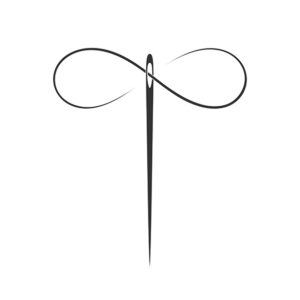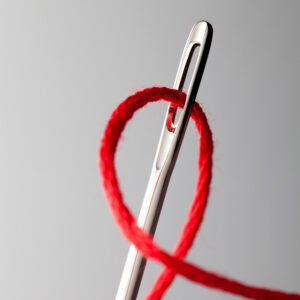 The sewing needle holds a special place in history. From its ancient beginnings where a precursor device was used to pierce skins and thread thin strips of hide or sinew together to the modern-day mass-produced steel tool, this humble implement has been an important part of human culture. During the Bronze and Iron Ages, along with the development of spinning and weaving techniques, people began making needles out of slender pieces of metal with a slot or “eye” formed through the metal at one end and a sharp point formed at the other end.
The sewing needle holds a special place in history. From its ancient beginnings where a precursor device was used to pierce skins and thread thin strips of hide or sinew together to the modern-day mass-produced steel tool, this humble implement has been an important part of human culture. During the Bronze and Iron Ages, along with the development of spinning and weaving techniques, people began making needles out of slender pieces of metal with a slot or “eye” formed through the metal at one end and a sharp point formed at the other end.
Needle making has a rich history, with a number of different styles being used throughout the centuries. The sewing needle is also one of the first examples of wire-making technology. It has been found in excavations of Gravettian archeological sites. Early religious texts reference needles as one of the five tools brought from Paradise by Adam and Eve. At a site in the northern deserts of China, researchers discovered needles that were more than 10,000 years old along with tools that may have aided in their creation. Some were wide and flat, perhaps used to stitch thick hides; others were narrow and circular, which may indicate that they were used for delicate work such as embroidery. In the past, sewing needles made of Gold and Silver were highly coveted wedding gifts for the very wealthy. Blacksmiths made needles from iron and other metals. It wasn’t until around 1640 that the first commercial needles were made in England. The industry took off and by the 18th century Redditch, England had become a hub for needle manufacture. Millions of steel needles were made every year. This early mass production made needles cheap and readily available to everyone.
Hand sewing is a labor-intensive process dependent upon the skills and abilities of the sewer. To sew a fine seam had always been the goal but, standardization of stitches was not possible until the needle was attached to a machine. A sewing machine, working at a much faster speed, could now guide the needle in making stitches that were of the same size, shape, and design. During the Industrial revolution, the development of the sewing machine helped workers to produce clothing quickly and uniformly. This also led to a decrease in the cost of garments, making them more accessible to a wider audience. The rise of the sewing machine has had a significant social impact as well. Automated sewing has aided the promotion of gender equality, provided jobs, and helped women become more independent. Both men and women were hired to work in factories to operate and maintain vast numbers of sewing machines. Home sewers, usually women, could create garments faster for their families or for private clients. At the heart of all this technological and social change is the humble sewing needle, one of the most important ancient technologies still in wide use today.
abilities of the sewer. To sew a fine seam had always been the goal but, standardization of stitches was not possible until the needle was attached to a machine. A sewing machine, working at a much faster speed, could now guide the needle in making stitches that were of the same size, shape, and design. During the Industrial revolution, the development of the sewing machine helped workers to produce clothing quickly and uniformly. This also led to a decrease in the cost of garments, making them more accessible to a wider audience. The rise of the sewing machine has had a significant social impact as well. Automated sewing has aided the promotion of gender equality, provided jobs, and helped women become more independent. Both men and women were hired to work in factories to operate and maintain vast numbers of sewing machines. Home sewers, usually women, could create garments faster for their families or for private clients. At the heart of all this technological and social change is the humble sewing needle, one of the most important ancient technologies still in wide use today.
